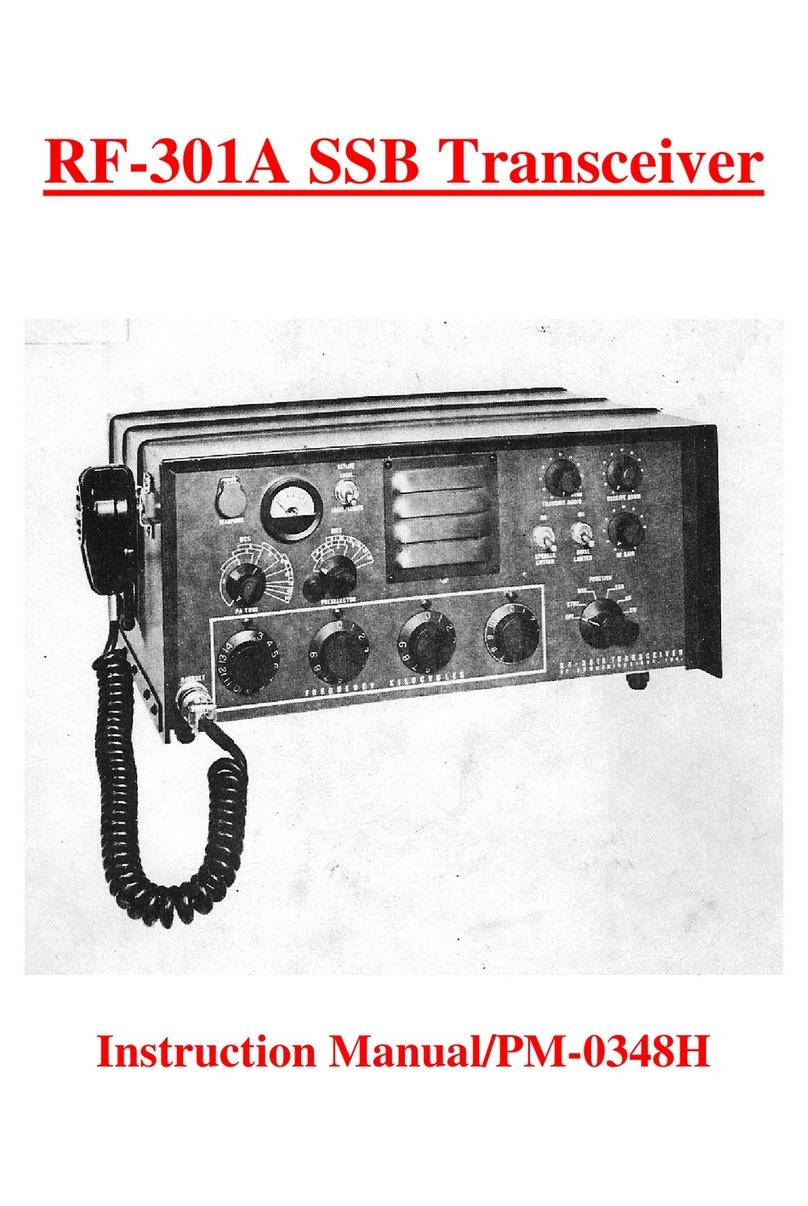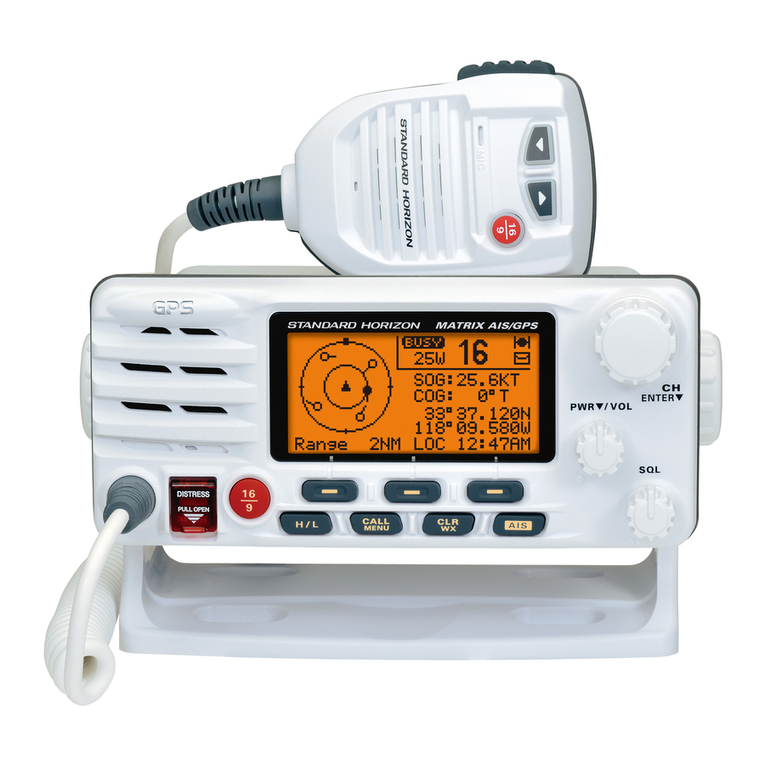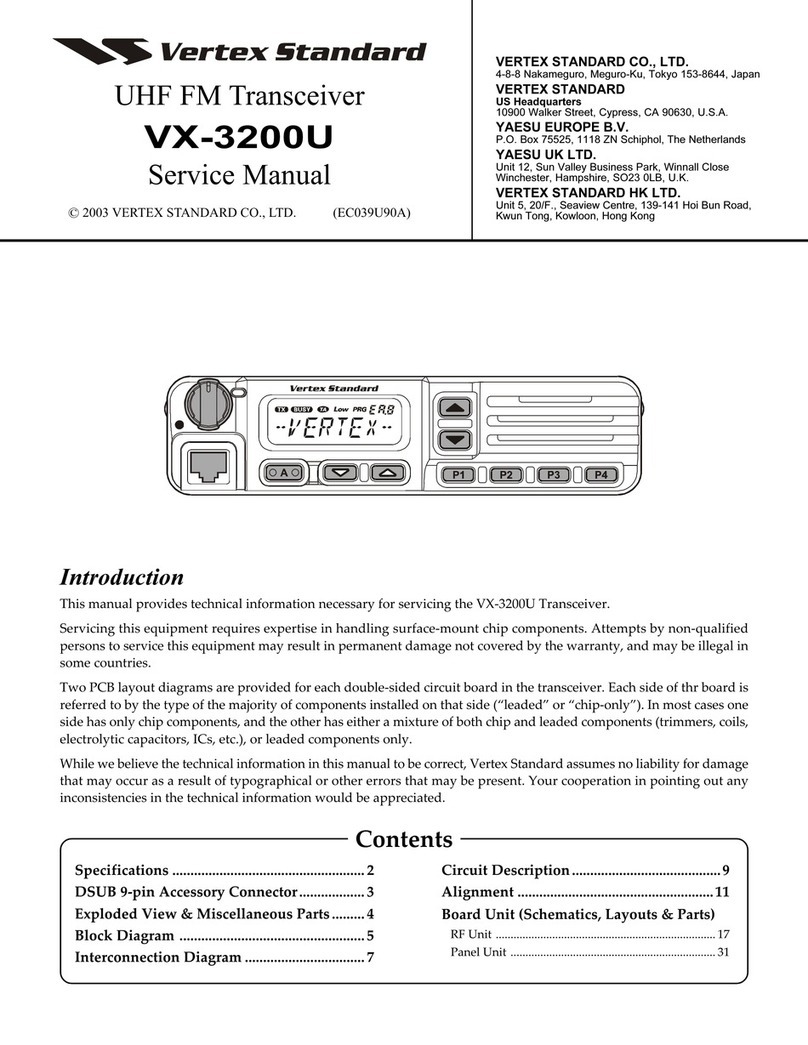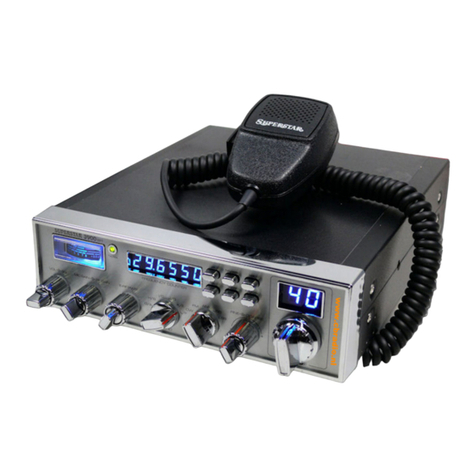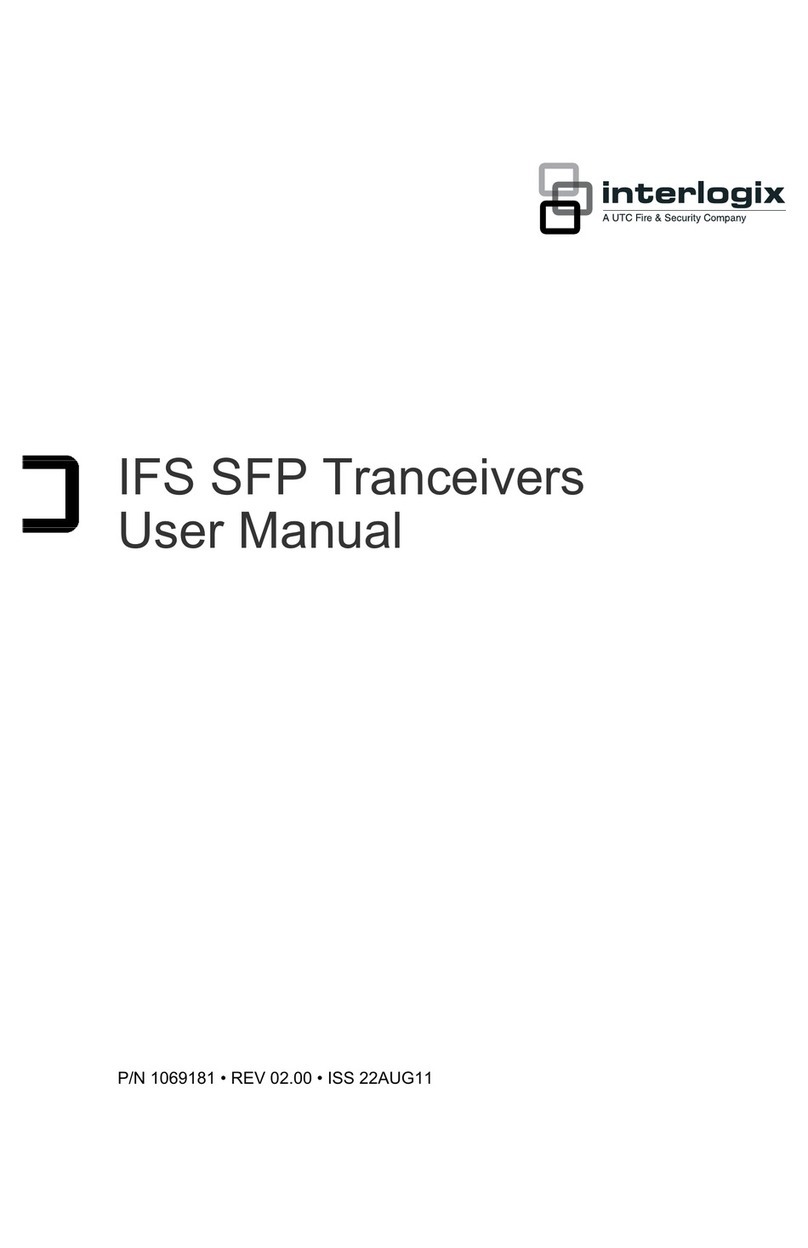Aurora IPX-TC3A Series User manual

Manual Number: 210125 | Firmware Rev: 1.0.3 & Above
www.auroramm.com
USERS GUIDE
IPX-TC3A Series
IPX-TC3A-C ● IPX-TC3A-CF Pro ●IPX-TC3A-DF Pro
IPX-TC3A-WP3-C/F Pro
SDVoE 10G 4K60 4:4:4 IP Distribution

USERS GUIDE
www.auroramm.com
ii
SAFETY INSTRUCTIONS
Please review the following safety precautions. If this is the first time using this model, then read this manual before
installing or using the product. If the product is not functioning properly, please contact your local dealer or Aurora for
further instructions.
The lightning symbol in the triangle is used to alert you to the presence of dangerous voltage inside the product
that may be sufficient to constitute a risk of electric shock to anyone opening the case. It is also used to indicate
improper installation or handling of the product that could damage the electrical system in the product or in other
equipment attached to the product.
The exclamation point in the triangle is used to alert you to important operating and maintenance instructions.
Failure to follow these instructions could result in injury to you or damage to the product.
Be careful with electricity:
Power Outlet:
To prevent electric shock, be sure the electrical plug used on the product power cord
matches the electrical outlet used to supply power to the Aurora product. Use the power adapter and power
connection cables designed for this unit.
Power Cord: Be sure the power cord is routed so that it will not be stepped on or pinched by heavy items.
Lightning: For protection from lightning or when the product is left unattended for a long period, disconnect
it from the power source.
Also follow these precautions:
Ventilation: Do not block ventilation slots, if applicable, on the product, or place any heavy object on top of
it. Blocking airflow could cause damage. Arrange components so that air can flow freely. Ensure that there
is adequate ventilation if the product is placed in a stand or cabinet. Put the product in a properly ventilated
area, away from direct sunlight or any source of heat.
Overheating: Avoid stacking the Aurora product on top of a hot component, such as a power amplifier.
Risk of Fire: Do not place unit on top of any easily combustible material, such as carpet or fabric.
Proper Connections: Be sure all cables and equipment are connected to the unit as described in this
manual.
Object Entry: To avoid electric shock, never stick anything in the slots on the case, or remove the cover.
Water Exposure: To reduce the risk of fire or electric shock, do not expose to rain or moisture.
Cleaning: Do not use liquid or aerosol cleaners to clean this unit. Always unplug the power to the device
before cleaning.
ESD: Handle this unit with proper ESC care. Failure to do so can result in failure.
FCC
This device complies with Part 15 of the FCC Rules. Operation is subject to the following two (2) conditions:
1. This device may not cause harmful interference.
2. This device must accept any interference received, including interference that may cause undesired operation.
Trademarks
All trademarks in this document are the properties of their respective owners.

USERS GUIDE
www.auroramm.com
ii
TABLE OF CONTENTS
PACKAGE CONTENTS .........................................................................................................................................................4
OPTIONAL ACCESSORIES ..................................................................................................................................................5
INTRODUCTION...................................................................................................................................................................10
About.................................................................................................................................................................................10
Documentation..................................................................................................................................................................10
Features ............................................................................................................................................................................11
IPX-TC3A and IPX-TC3A Pro Front..................................................................................................................................12
IPX-TC3A-CF, IPX-TC3A-DF Rear...................................................................................................................................14
IPX-TC3A-WP3-C and IPX-TC3A-WP3-F Front...............................................................................................................15
IPX-TC3A-WP3-C and IPX-TC3A-WP3-F Rear................................................................................................................16
UNDERSTANDING THE BASICS........................................................................................................................................17
Direct Connection with No Ethernet Switch......................................................................................................................17
10GbE Ethernet Switch.....................................................................................................................................................17
10GbE Ethernet Port Usage .............................................................................................................................................17
Network Infrastructure.......................................................................................................................................................17
Isolated Network or Users Network ..................................................................................................................................17
Controlling the IPX............................................................................................................................................................18
Controlling the IPX with Multiple Servers for Redundancy...............................................................................................18
EDID and its Importance...................................................................................................................................................18
Video Wall Capabilities IPX-TC3A Pro .............................................................................................................................19
HARDWARE INSTALLATION .............................................................................................................................................20
Network Setup...................................................................................................................................................................20
Encoder Setup...................................................................................................................................................................20
Decoder Setup ..................................................................................................................................................................20
RXS-1 Control Server Setup.............................................................................................................................................21
Control Setup ....................................................................................................................................................................21
APPLICATIONS....................................................................................................................................................................22
Example 1: IPX-TC3A-WP Configured as Transmitter to IPX-TC3A Configured Receiver..............................................22
Example 2: IPX Multi-Room..............................................................................................................................................23
Example 3: Matrix – Multiple IPX to Multiple IPX..............................................................................................................24
Example 4: Video Wall......................................................................................................................................................25
Example 5: KVM Utilizing USB 2.0 ...................................................................................................................................26
SOFTWARE..........................................................................................................................................................................27
IPBaseT Manager/IPBaseT Manager Pro ........................................................................................................................27

USERS GUIDE
www.auroramm.com
iii
CONNECTOR PIN DEFINITION...........................................................................................................................................29
HDMI.................................................................................................................................................................................29
CAT5e/6/6A.......................................................................................................................................................................30
RS-232..............................................................................................................................................................................31
IR (Infrared).......................................................................................................................................................................32
APPENDIX 1.........................................................................................................................................................................33
Troubleshooting ................................................................................................................................................................33
APPENDIX 2.........................................................................................................................................................................35
Firmware Update...............................................................................................................................................................35
APPENDIX 3.........................................................................................................................................................................36
Protocol.............................................................................................................................................................................36
APPENDIX 4.........................................................................................................................................................................37
Recommended Cabling.....................................................................................................................................................37
APPENDIX 5.........................................................................................................................................................................38
Recommended Network Switches....................................................................................................................................38
APPENDIX 6.........................................................................................................................................................................40
Technical Specifications....................................................................................................................................................40
APPENDIX 7.........................................................................................................................................................................41
Warranty............................................................................................................................................................................41

USERS GUIDE
www.auroramm.com
4
PACKAGE CONTENTS
Please make sure the following items are included within your package. Contact your dealer if any items are missing or
damaged. Go to www.auroramm.com for latest manual and firmware.
Box Versions
IPX-TC3A-C
1 QTY IPX-TC3A-C 10G RJ-45 Copper Transceiver Unit.
2 QTY Mounting Ears and screws
IPX-TC3A-CF-PRO (Scaling, Video Wall, Windowing, Seamless Switching)
1 QTY IPX-TC3A-CF-PRO 10G RJ-45 Copper/Fiber Transceiver Unit. SFP+ module sole separately.
2 QTY Mounting Ears and screws
IPX-TC3A-DF-PRO (Scaling, Video Wall, Windowing, Seamless Switching)
1 QTY IPX-TC3A-DF-PRO 10G Dual Fiber Transceiver Unit. SFP+ module sold separately.
2 QTY Mounting Ears and screws
Wall Plate Versions
IPX-TC3A-WP3-F-Pro (3 Gang, Scaling, Video Wall, Windowing, Seamless Switching)
1 QTY IPX-TC3A-WP3-F 10G Fiber Transceiver Unit in white (IPX-TC3A-W3P-F-W) or black (IPX-TC3A-WP3-F-B).
SFP+ module sold separately.
IPX-TC3A-WP3-C-PRO (3 Gang, Scaling, Video Wall, Windowing, Seamless Switching)
1 QTY IPX-TC3A-WP3-C 10G RJ-45 Copper Transceiver Unit in white (IPX-TC3A-WP3-C-W) or black
(IPX-TC3A-WP3-C-B).
Power supplies are sold separately.
*Note: Go to www.auroramm.com for latest manual and firmware.

USERS GUIDE
www.auroramm.com
5
OPTIONAL ACCESSORIES
RK2-1-K
(1RU Rack Mount Holds 2 Units)
Includes 4 Rails and 1 Blank
RK2-5-K
(5RU Rack Mount Holds 12 Units)
Includes 24 Rails and 4 Blanks
RK2-BP-K
(Blank Plate for Rack Mounts)
RK2-RL-K
(Rails for IPX-TC3A Use in Rack Mounts)
IPE-USB-2
(USB 2.0 Extreme USB Option Card)
IPE-USB-2VH
(USB 2.0 Extreme USB Option Card with Virtual Hub)

USERS GUIDE
www.auroramm.com
6
IPE-DTE-1
(2 Channel Dante®/AES67 Option Card)
IPE-DTE-2
(8 Channel Dante®/AES67 Option Card)
IPE-ReAX-1
(ReAX Control System Option Card)
IPE-LCVR-(W/B)
(IPX Wall Plate LAN Port Cover)
RXS-1
(ReAX Linux Server with IPBaseT Manager Pro)

USERS GUIDE
www.auroramm.com
7
DXB-8/DXB-8i
(8 Button Wall Plate)
PS0081-1
(48V 24-Watt PoE Injector)
Available in –US, -AU, -EU, and –UK worldwide models
PS0094-3
(48V 25-Watt Wall Supply for Wall Plates)
Comes with US, AU, EU, and UK interchangeable blades
IR Receiver CA0026-1
IR Emitter CA0061-1

USERS GUIDE
www.auroramm.com
8
IR Blaster CA0049-1
RS-232 Adaptor CA0052-F2T3R
(3.5mm TRS to FEMALE DB89 2-TX 3-RX)
RS-232 Adaptor CA0052-F3T2R
(3.5mm TRS to FEMALE DB89 3-TX 3-RX)
RS-232 Adaptor CA0052-M2T3R
(3.5mm TRS to MALE DB9 2-TX 3-RX)
RS-232 Adaptor CA0052-M3T2R
(3.5mm TRS to MALE DB9 3-TX 2-RX)
LVR-3G Gang Electrical Ring
IPA-SFP-10GMM-1
(10G SFP+ Multi-Model LC 50/125 Module)
IPA-SFP-10G32C1
(10G SFP+ BIDI Single Mode 1330/1270nm Module 10KM)

USERS GUIDE
www.auroramm.com
9
IPA-SFP-10G23C1
(10G SFP+ BIDI Single Mode 1270/1330 Module 10KM)
IPA-SFP-10G20
(10G SFP+ Single Mode Dual Module 1310nm 20KM)
IPA-SFP-PPC-1
(SFP+ 10G Passive Patch Cable 1M (3ft)
IPA-SFP-OM3DXLC-1
(OM3 Fiber 50/125 Multi-Mode LC Patch Cable 1M)

USERS GUIDE
www.auroramm.com
10
INTRODUCTION
About
The IPX Series provides one of the most advanced IP Streaming solutions on the market utilizing SDVoE technology. It is
the industry’s first 4K2K transceiver with zero compression (4K60 4:2:0, 4K30 4:4:4), lossless compression (4K60 4:4:4),
and zero frame latency based on BlueRiver NT+ platform. Using a transmitter (encoder) and receiver (decoder),
respectively, used to be the standard – until now. The IPX can be set up as either one to make installation, inventory, and
troubleshooting easier. Another industry first is the option slot to add other IP capabilities, like ExtremeUSB®(USB 2.0
over IP) or Dante®audio, for a more complete, distributed system.
Audio, video, data, and control can be sent securely to one or many units using off-the-shelf 10G Ethernet switches.
When the IPX is set up to be a transmitter, the 2 HDMI inputs become a source switch and the HDMI output becomes a
potential loop out. When set up as a receiver, a user can select the local HDMI inputs or an IP source. Seamless
switching of the sources further enhances the presentation. Regardless of how the IPX is set up, the audio can be de-
embedded at any location, break away, and/or be sent to or received from a Dante®enabled device. The USB 2.0 option
is also flexible, working as a KVM and/or a high-speed data transfer (480Mbps) for memory sticks. Each IPX USB feature
can also be set as a host or a device. To keep the system friendly, a customizable OSD and web server are available to
be programmed as required. For RJ-45 LAN devices, the 1G Ethernet port allows full bandwidth end-to-end over the IPX
10G fiber or copper port.
Choice is important. That’s why the IPX fiber version has an SFP+ port that can use single or multi-mode fiber – making
the IPX Series the ultimate AV IP product on the market today.
Documentation
Aurora provides many documents to support the IPX series and accessories. Below is a list of the available documents
that can be found on the download tab of the IPX products or the customer portal.
IPX Series Network Switch Recommendation and Configuration
RXS-1 User Guide
IPBaseT Manager Users Guide
IPX Series Protocol Guide (Available only on Customer Portal)
IPBaseT FAQ (Frequently Asked Questions)
IPBaseT IPX Series AV Evolution for an Industry Revolution (Features and the benefits over tradition Matrix)
IPBaseT Brochure

USERS GUIDE
www.auroramm.com
11
Features
Configure as Transmitter (Encoder) or Receiver (Decoder)
4K60 4:4:4 Over 10G Fiber or Copper
Zero Compression/Frame Latency (22us) for 4K60 4:2:0 and below
1.3:1 Lossless Compression and Zero Frame Latency (100us) for 4K60
4:4:4
Network Redundant operation (IPX-TC3A-DF)
Secure Content Encryption
128x128 Capable with HDCP, Larger for Non-Encrypted Sources
Video Wall Capability 8x8 (Pro Version)
Windowing/Multi-viewer up to 32 windows (Pro Version)
3ms Scaling (Pro Version)
Seamless Switching (Pro Version)
Break-away Switching
Audio DSP
SFP+ for Multi/Single Mode Fiber
10/100/1000Mbps LAN PoE (PD)
2 HDMI Inputs, 1 HDMI Output
Line In/Out Stereo
RS-232 Serial Port and IR (Bidirectional)
Integrated Web Server for Custom Control Pages
USB 1.1 (HID) or USB 2.0 480Mbps with Option Card
Dante®/AES67 IP 2Ch and 8Ch Audio Option
ReAX IP Control Option
Front Keypad with OLED Display
Auto Sense Switching
Rack and Under Table Mounting
Wall Plate Versions in white or black
*Note: Wall plate versions require full 3 gang electrical box space. Some electrical boxes and mud rings do not
accommodate the full size. IPX-TC3A-WP3 wall box dimensions are 5.54” x 2.83” x 1.404”. Wall box portion depth
is 1.404” without option card and 1.5" with option card.
IPX-TC3A
IPX-TC3A-WP3-W
IPX-TC3A-WP3-B

USERS GUIDE
www.auroramm.com
12
IPX-TC3A and IPX-TC3A Pro Front
LEDs
Power/Status: Power will light green when unit is on or in standby. Status will blink at a normal pace during regular
operation and slower pace when in standby.
OLED:128x64 pixel OLED. Will display status of the following in addition to IP Address and Serial number.
1. Encoder/Decoder: Encoder (transmit) or Decoder (receiver) will be lit when set accordingly.
2. SFP TX/RX: Will blink when data is being transmitted or received for fiber or copper versions.
3. Link/Activity: Link will blink when a USB module is detected and will be lit solid when it is connected to another
IPE-USB-2 or UPE-USB-2VH. Activity will blink when USB data is being transferred.
4. HDMI 1/HDMI 2: Will light accordingly based on input selection. If both are lit, then it is the remote stream when
set as a decoder. If neither is lit, then no source is routed.
5. 232 TX/RX: Will blink when RS-232 data is being sent or received.
6. IR TX/RX: Will blink when IR signal is being sent or received.
7. Host/Device: For USB option. Host will be lit if set for PC to be connected to the USB. Device will be lit if set for
peripherals like keyboard or mouse is to be connected.
Buttons
Menu Button: Press and hold for 5 seconds switch between encode and decode mode. Also, cycles through the
OLED Menu.
Enter Button: Selects the current menu option.
Up Button: Select next input source.
Down Button: Select previous input.
Up/Down Button: Press and hold for 5 seconds to output IP info at 9600 baud rate on RS-232 port.
Miscellaneous
USB Dual Type A: 480Mbps USB 2.0 for device (ex. Mouse, keyboard, etc.). Extreme USB option card (IPE-USB-2)
must be installed for USB to function as 2.0. If option card is not installed the USB will work at USB 1.1
IR Input: IR input 30kHz-60kHz. Photo Receiver must be stereo 3.5mm TRS.
*Note: It is important to use 5V only photo receiver which is with carrier and inverted.

USERS GUIDE
www.auroramm.com
13
IR Window: Future use for IR remote.
Special Functions
Factory Default: Press and hold Select and Up together for 4 seconds.
*Note: Default Settings – 9600 baud rate; default IP 192.168.1.100; autosense off.

USERS GUIDE
www.auroramm.com
14
IPX-TC3A-C, IPX-TC3A-CF-Pro, IPX-TC3A-DF-Pro Rear
Rear
10G: RJ-45 10G network connection for the IPBaseT connectivity. Unit can be powered with 10G PoE or PoH
injector.
10G SFP+: Multi-mode or single mode SFP+ 10G modules for the IPBaseT connectivity.
HDMI 2.0 In 1/2: HDMI inputs.
HDMI 2.0 Out: HDMI Output to Display.
RS-232: Serial port pass-through and control up to 115Kbps.
IR Out: IR output 30kHz-60kHz. Emitter must be mono 3.5mm TS.
Audio Line In/Out: Stereo audio input/Stereo de-embedded output.
Ethernet: 10/100/1000Mbps LAN. Can power the unit with PoE from injector or switch.
USB: 480Mbps USB 2.0 Micro to be connected to a host PC. Extreme USB SO-DIMM option card (IPE-USB-2) must
be installed for USB to function.
Inside
Option Card Slot for USB 2.0 and ReAX or Dante®.
*Note: The MAC address for the Dante or USB option will be on the card label.

USERS GUIDE
www.auroramm.com
15
IPX-TC3A-WP3-C and IPX-TC3A-WP3-F Front
Buttons
HDMI 1: Selects HDMI Input 1 (Lights Red, Green, or Blue).
HDMI 2: Selects HDMI Input 2 (Lights Red, Green, or Blue).
Remote Stream: Selects remote stream assigned when set as decoder (Lights Red, Green, or Blue). If held for 5
seconds will switch between encode and decode modes. Stream button will light blue when in encode mode.
Connectors
HDMI In 1/2: HDMI inputs.
HDMI Out: HDMI Output to Display.
Audio In: Stereo audio input.
Audio Out: Audio de-embedded output.
Ethernet: 10/100/1000Mbps LAN.
USB: 480Mbps USB 2.0 Type A to be connected to a host (PC) or device (i.e., Mouse, keyboard, etc.). Extreme USB
option card (IPE-USB-2) must be installed for USB to function.
Miscellaneous
IR Window: Future use for IR remote.
Special Functions
Streaming Factory Default: Press and hold HDMI 1 for 5 seconds. This will only restore default for the mode the
unit is currently set to.
Web Server Factory Default: Press and hold HDMI 2 for 5 seconds.
*Note: Default Settings - 9600 baud rate; default IP 192.168.1.100; autosense off.

USERS GUIDE
www.auroramm.com
16
IPX-TC3A-WP3-C and IPX-TC3A-WP3-F Rear
Rear
48VDC: 48 Volt isolated power input.
SFP+: For multi-mode or single mode SFP+ 10G modules (IPX-TC3A-WP3) for the IPBaseT zero
compression/latency connectivity.
10G: RJ-45 10G network connections ((IPX-TC3A-WP3) for the IPBaseT zero compression/latency connectivity. Unit
can be powered with 10G PoE or PoH injector.
RS-232: Serial port pass-through and control up to 115Kbps. Also, a 5V for connection to DXB-8 8 button wall
controller.
Expansion Slot for USB, ReAX, and Dante options. Cover supplied for card protection.
*Note: Copper RJ-45 is tab down. Do not use a boot over the connector or it will be too snug. To release the
cable a flat head screwdriver should be used from the side to lift tab from underneath.
Wall plate versions require full 3 gang electrical box space. Some electrical boxes and mud rings do not
accommodate the full size. IPX-TCW3 wall box dimensions are 5.54” x 2.83” x 1.404”. Wall box portion depth is
1.404” without option card and 1.5" with option card.

USERS GUIDE
www.auroramm.com
17
UNDERSTANDING THE BASICS
Direct Connection with No Ethernet Switch
The IPX Series is designed to automatically tunnel the video, audio, USB, RS-232, and IR if they are connected without
an Ethernet switch or connected server (RXS-1).
10GbE Ethernet Switch
It is important to use a non-blocking IGMP 10GbE switch with IGMP snooping. The size of the switch is based on the
requirements of the project. Keep this in mind if extra port capacity is required for future expansion. If you run out of port
capacity, you can always add another 10GbE switch in the future. The IPX, when set to encoder (TX), determines the
bandwidth that will be multicast across the network. 24bit 4k@30Hz will use about 6Gbps and 3Gbps for 24bit
1080p@60Hz (Data Rate in bits per second = Color Depth x Horizontal Resolution x Vertical Resolution x Frame Rate). If
the bandwidth is higher the 1.3:1 compression will be utilized so a 4K60 4:4:4 will be around 9Gbps. The IPX also can
enable the 1.3:1 lossless compression for any resolution allowing 1080p60Hz to be about 1.5Gbps. This does not include
the 1G LAN, 480Mbps, RS-232, IR over the same transmission if required. If 10 units are set as encoders, and 4K@30Hz
is the desired video resolution, then 64Gbps of bandwidth will be required if uplinked to another switch. If the available
bandwidth between the 2 10GbE switches is less than 64Gbps, then packets will drop, and information will be lost. It is
also a good idea to consider overhead and assume 15% bandwidth loss to play it safe. Since each port is bi-directional
10Gbps, it enables any port to be used as an encoder or decoder. The AV industry is used to standard distribution
topology limitations of 4x4, 8x8, 16x16, etc. With networked based video distribution, a 48 port 10GbE switch as an
example can be 24x24, 1x47, 47x1, 12x36, etc.
10GbE Ethernet Port Usage
The 1GbE LAN port on each IPX unit is a full bandwidth independent port that is part of the 10GbE switch. For every IPX
unit added to the 10GbE network, it is the same as adding another 1GbE LAN port to a switch. Every IPX 1GbE LAN port
is part of a 1GbE switch, relative to the number of IPX units on the network. This allows for using the IPX in place of a
secondary 1GbE Ethernet infrastructure to each location and even using it as a low bandwidth video streaming, within the
high bandwidth streaming. It is important to not connect more than one IPX unit into the same 1GbE network or there will
be communication issues. If more than one IPX unit is connected into the same 1GbE network, it would be the same as
taking 2 Ethernet switches and connecting multiple ports to each other, as action that will totally disrupt the network (it will
cause a broadcast/network storm). Connecting computers or other LAN peripherals throughout the IPX 1GbE LAN ports
will work the same as any other Ethernet switch typically used. A more advanced usage would be to use the IPX 1GbE
LAN port to have a local H.264 encoder send lower bandwidth content over the IPX 10GbE infrastructure. This way local
AV content is sent real time uncompressed using the 10GbE IPX infrastructure and then for distant learning, computer
viewing, or internet usage the H.264/H.265 compressed stream using the same 10GbE infrastructure to other low
bandwidth destinations.
Network Infrastructure
The raw network cabling as well as the patch cables are as important as the switch. For 10GbE networks fiber cable is
preferred. If using copper, unshielded cable is preferred for optimal performance and is important to follow the standard
rules for running Ethernet cables. No sharp bends, coiling, putting near power lines, grouping tightly together with other
LAN cables, etc. The grade of the copper cable is important too as it will determine the distance. CAT6A will reach 100m,
CAT6 55m, and CAT5e 40m. Fiber can achieve substantially greater lengths and does not have the issues of copper with
running together, power line interference, etc. OM3 multi-mode fiber (MMF) will go almost 1000ft/300m. Single-mode fiber
(SMF) can go tens of miles if required.
Isolated Network or Users Network
When discussing a networked based video solution, many times it is assumed it has to be on the client’s network. This is
not true. The application determines the type of network to be used. For example, if it is simply being used as a typical AV

USERS GUIDE
www.auroramm.com
18
matrix switch with no distribution throughout the facility, then a 10GbE switch can be used just for that room. Just because
it is Ethernet based does not mean it has to be used on the main network. The Ethernet switch is simply used as the end
point for all the cables and the glue that holds everything together. In other words, it takes the place of the standard AV
matrix switch topology. If only remote control is required from the main network, then connect the 10GbE switch to the
main network and allow the control data between the 10GbE switch VLAN and the main network. Even if the VLAN is part
of the main network it does not mean you will use all the bandwidth. The purpose of IGMP is to only send the multicast
data to the ports specified, which would be where the IPX units are connected to. Non-blocking switch assures full
bandwidth is available for all ports as required.
Controlling the IPX
To simplify control of the IPX, the RXS-1 ReAX Server is available. It is a fanless i5 processor industrial grade Linux
server, which mitigates all communications to all the IPX units (devices and wall plates). The RXS-1 serves up Aurora’s
IPBaseT Manager Pro to any regular or mobile web browser. ReAX is a Javascript based IP control system as well
allowing full room/building automation or if desired a third-party control systems can be utilized with the available API. In
order to obtain the IPX Server API commands you must be dealer status otherwise an NDA is required and is at the
discretion of Aurora.
Controlling the IPX with Multiple Servers for Redundancy
Multiple RXS-1 servers can run on the same network for redundancy. It is important only one communicates at any given
time or incomplete commands may occur between units communicating simultaneously. IPBaseT Manager will only
connect to one server at a time but it is important for every PC running IPBaseT Manager they all point to the same server
at the same time. If a server losses communication, then all clients should reconnect to the same backup server.
When using third party control systems, this can be done automatically. Have the control system send a query to the
RXS-1 to receive a response through the telnet connection. If no response is received, have the third-party control device
target the backup server until the main server starts to communicate again. Do not use ping for this operation as it only
confirms a network connection but does not confirm actual IPX API Server operation. Pinging will be effective for
diagnostics to determine if the network connection to the server is lost or if there are significant delays in the network.
EDID and its Importance
One of the most forgotten setup procedures in AV systems is the EDID. The EDID comes from the destination (display,
VTC, recorder, etc.) and must be saved into the encoder and decoder HDMI input ports. This allows the source (Blu-ray,
computers, etc.) to know the capabilities of the destination. This includes the audio type if any, video resolution and
timing, color space, color depth, and more. If no EDID is present an HDMI device will revert to lowest resolution in DVI
mode which also means no audio. If the wrong EDID is used, the image may look pink, green, or have no image at all. To
make matters more complex, if different destinations/displays are in use in a matrix configuration, then it is important to
use an EDID with a common denominator or only one or the other destination may work. In an ideal installation all the
destinations should have the same capabilities for optimal performance. I this is not possible a scaler may have to be
implemented to assist in the compatibility.
For example, there are 2 displays one 1080p the other 4k UHD. If the EDID of the 4K display is used, the 1080p will not
see an image if the source is capable of 4K. If the 1080p EDID is used, then both will see the image but the 4K will never
benefit from 4K content. In a situation where this is unacceptable, a 4K scaler can be used on the 1080p screen to down
scale the 4K content so the 4K EDID can be used and the better screen can have a benefit. Note scalers do add frame
latency and can affect image quality based on the quality of the scaler. This is why it is always ideal to use destinations
with similar capabilities for optimal performance.
Audio can be impacted just as easily. If a destination is 6-channel surround sound capable and the other destination is
not, then the EDID from the 5.1 destination cannot be used, or there will be no audio on the other destination. In most
commercial installations it should not be an issue to choose the lowest common denominator, which is 2-channel audio,
but in cases where you must have surround sound then a down-mixer for the 2-channel destination must be used.

USERS GUIDE
www.auroramm.com
19
In some cases, a custom EDID could be created, as the audio and video are mismatched between the destinations. This
can occur for example, when one destination has 4K 2-channel audio and the other 1080p with multichannel surround
sound. If the EDID of the 1080p destination is used, audio will not be present on the 4K destination. If the 4K EDID is
used, there will be no video present on the 1080p destination. The only way to solve this issue, is a new EDID combining
the common features. In this case an EDID which is set at 1080p with 2-channel audio is the solution.
Video Wall Capabilities IPX-TC3A Pro
The IPX-TC3A Pro video wall mode has the ability to take in a 4K60 UHD signal and create a low latency high quality
video wall. With its internal low latency 3ms scaler, video walls can be created up to 8x8 for basic video wall configuration
and 16x16 with additional bridging technique.
This manual suits for next models
5
Table of contents
Other Aurora Transceiver manuals
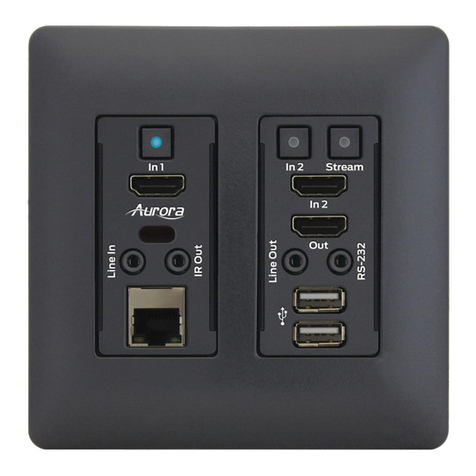
Aurora
Aurora VLX-TCW2H-C User manual
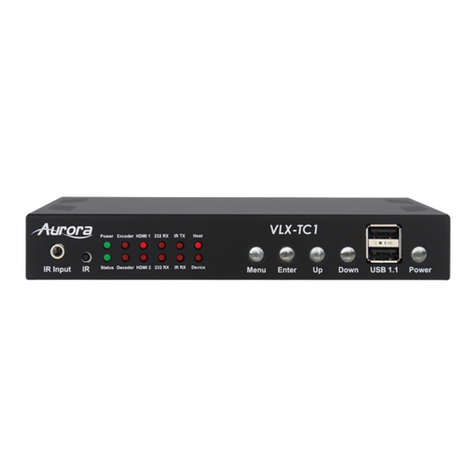
Aurora
Aurora IVLX-TCW2V-C User manual
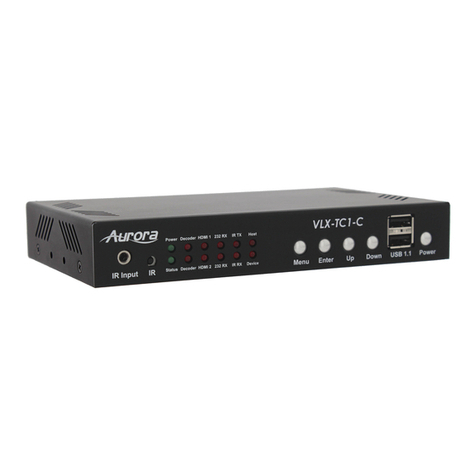
Aurora
Aurora VLX-TC1-C User manual
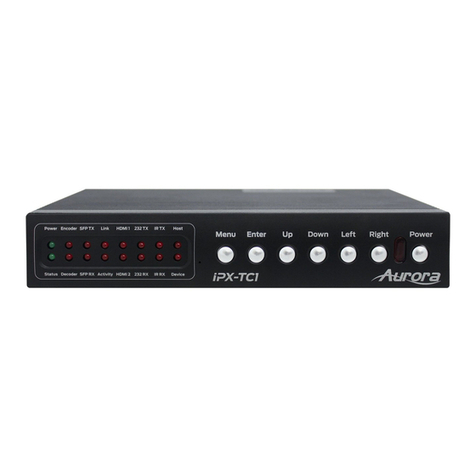
Aurora
Aurora IPX-TC1-F User manual
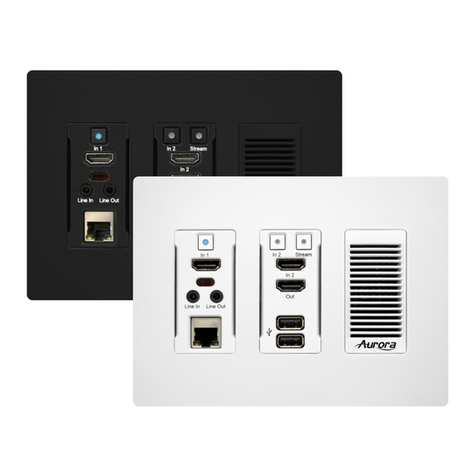
Aurora
Aurora IPX-TC3 Series User manual
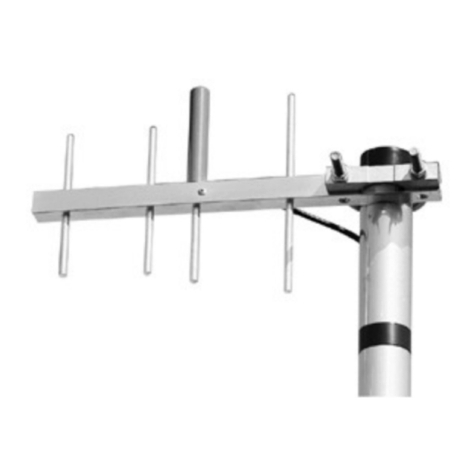
Aurora
Aurora MLink Ultra User manual
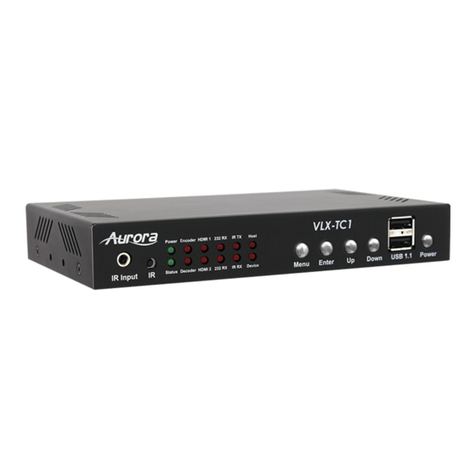
Aurora
Aurora VLX-TC1-CF User manual

Aurora
Aurora IPX series User manual

Aurora
Aurora VLX-TC1-C User manual






